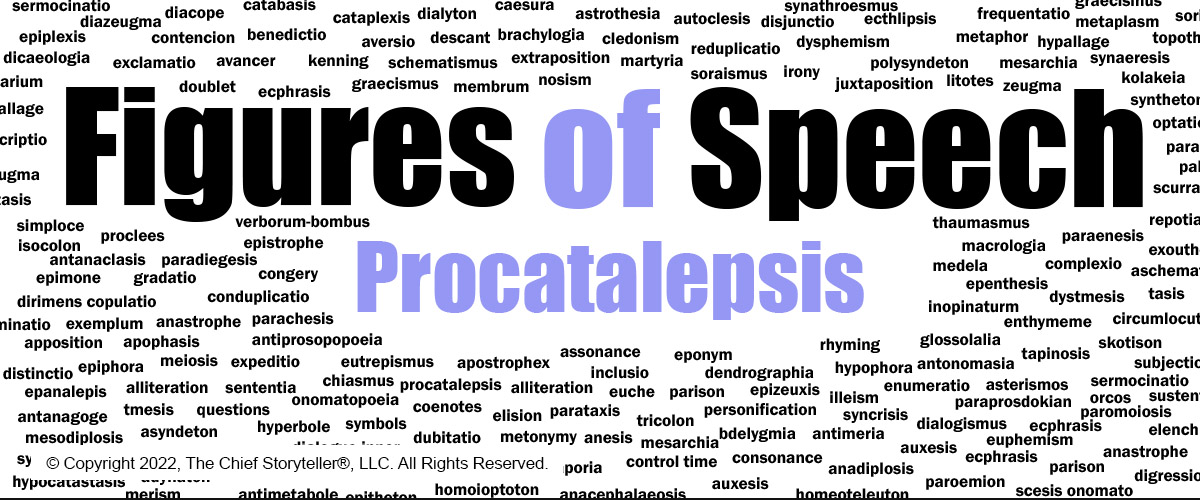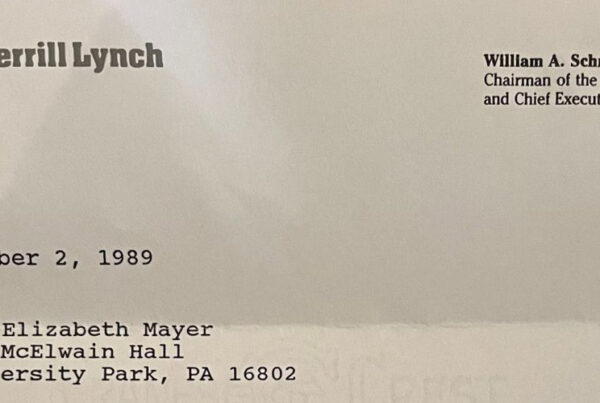
Procatalepsis is a Figure of Impact for improving persuasion and influence. As a betting person, I would bet you one billion Monopoly® dollars, you use Procatalepsis frequently, likely as much as daily.
Procatalepsis is a strategy of prebuttal and counter-argument, where you take into account your audience’s objections. You may even want to concede certain points as well as empathize with your audience. In influence and persuasion, as the communicator, you are ensuring your ideas/points sound stronger and therefore, should be adopted. The level of intensity of the prebuttal is up to you — you must Know Your Audience!
The desired outcome is you demonstrate you have done your homework and show your audience you appreciate their points of view. Consider using Procatalepsis in data storytelling, budgeting, planning meetings, training, and so much more. [Note, using questions is hypophora, a form of Procatalepsis]
I share figures of speech, as the English language has hundreds of literary devices to help you (dramatically) improve the effectiveness and impact of your various communications.
Whatever your goal, what is most important is the application of each figure of speech in your written, spoken, and social media communication.
When I do my consulting, workshops, training, and teach my class on public speaking and storytelling (I’m an adjunct professor at The Robert H. Smith School of Business at the University of Maryland), I tell them all…
“You never have to remember the actual Greek word for the figure of speech.
You DO have to remember the concept and proper use of it.”
Emphasis & Impact Figures of Speech include Anadiplosis, Anaphora, Asyndeton, Diacope, Epanalepsis, Epiphora, and Polysyndeton.
Amplification Figures of Speech include Auxesis and Epizeuxis,
Figures of Sound include Onomatopoeia.
Other Figures of Speech include Procatalepsis and Portmanteau.
There are three major sections:
- Figure of Speech. Includes a little background, usage, definition, pronunciation, other related figures of speech, and etymology.
- Usage Guidelines. Follow these guidelines to ensure maximum impact.
- Examples of Procatalepsis. Find examples from speeches, presentations, presidential addresses, poems, music, and more
1) PROCATALEPSIS – FIGURE OF IMPACT
Common examples of using Procatalepsis are when you say phrases in anticipation of your audience’s reaction. Examples include, “you may ask…”, “I know what you are thinking…”, and “some of you might wonder…”
A well-crafted sentence with Procatalepsis takes into account your audience’s potential and current opposition. And defends them or acknowledges their counterpoint is true ahead of time to move the argument forward.
| Definition | Procatalepsis is a strategy of prebuttal or counter-argument, where you include preemptive language that refutes and discredits your audience’s objections |
| Pronunciation | pro – kat – uh – lep – sis |
| Also Known as | Prolepsis, Prebuttal, Anticipatio |
| Related to | Hypophora (Ask questions and then answer them) |
| Etymology | Derived from the ancient Greek word προκατάληψις, meaning “seizing in advance.” From words, προ (“pro” or “before”) and κατάληψις (“seizing”) |
2) USAGE GUIDELINES
Here are some guidelines for you to ensure Procatalepsis, achieves your communication goals:
| Use Deliberately | The strength of Procatalepsis as a strategic figure of impact, is in doing your research. Know Your Audience! |
| Combine with Other Figures of Speech |
Procatalepsis in and of itself, is not a figure of speech for improving your presentation, training, story, etc. I recommend combining Procatalepsis with repetition figures of speech (e.g., Alliteration, Anaphora, and Diacope) and amplification figures of speech (e.g., Auxesis, Epizeuxis, and Pleonasm) to truly achieve your goals. |
| Emphasize with Your Voice | In my training and teaching, I share specifics on how to use one’s voice to add (dramatic) impact to your spoken communication. Think of yourself as an orchestra with three main instruments: Your Words, your Body Language, and your Voice. Varying your tone of voice, cadence, and speed are what separates a great speaker from a good speaker. |
3) EXAMPLES
Look at the examples below. See how Procatalepsis is used to increase the effectiveness and impact of your words. Then experiment, mixing and combining other figures of speech for repetition and amplification in your written, spoken, and social media communication.
Examples of Procataleptic phrases:
- “You may ask …”
- “Some of you might be wondering …”
- “I know what you are thinking …”
- “I know what you are going to say …”
- “You may misunderstand the concept that …”
- “Perhaps you know it already …”
- “Why should I/you care about it? Because… ”
- “This might be interpreted as …”
- “I know this is counter to …”
- “My ideas may be challenge our …”
Example 1: The Captives by Hugh Walpole
| Without Notation | “I recognize what you’re going to say” … “That if they study it well they’ll see that it wasn’t our fault. But will they look at it properly? Of route they won’t. You realize what cats they’re …” |
| With Notation |
“I recognize what you’re going to say” … “That if they study it well they’ll see that it wasn’t our fault. But will they look at it properly? Of route they won’t. You realize what cats they’re …” |
Example 2: Apology by Plato
| Without Notation | Someone will say: “Yes, Socrates, however can’t you maintain your tongue, and then you can go into a foreign city, and no person will intrude with you?” Now I have tremendous issue in making you understand my answer to this … and that the lifestyles that’s unexamined isn’t worth living – which you are still less probable to trust. And yet what I say is true, despite the fact that a issue of which it is difficult for me to persuade you. |
| With Notation |
Someone will say: “Yes, Socrates, however can’t you maintain your tongue, and then you can go into a foreign city, and no person will intrude with you?” Now I have tremendous issue in making you understand my answer to this … and that the lifestyles that’s unexamined isn’t worth living – which you are still less probable to trust. And yet what I say is true, despite the fact that a issue of which it is difficult for me to persuade you. |
Example 3: A Modest Proposal by Jonathon Swift
| Without Notation | I can think about nobody objection that will in all likelihood be raised against this proposal, unless it need to be entreated that the range of human beings can be thereby lots lessened inside the kingdom. This I freely personal, and it was indeed the most important layout in presenting it to the world. |
| With Notation |
I can think about nobody objection that will in all likelihood be raised against this proposal, unless it need to be entreated that the range of human beings can be thereby lots lessened inside the kingdom. This I freely personal, and it was indeed the most important layout in presenting it to the world. |
Example 4: The Scorpio Illusion by Robert Ludlum
| Without Notation | “Please,” interrupted Cooke.
“I haven’t finished. To anticipate your objection, he’s a retired officer of US Naval Intelligence. He’s relatively young, early to mid-forties, I’d say, and I’ve no real knowledge of why he left the service, but I gather the circumstances weren’t very pleasant. Still, he could be an asset on this assignment.” |
| With Notation |
“Please,” interrupted Cooke.
“I haven’t finished. To anticipate your objection, he’s a retired officer of US Naval Intelligence. He’s relatively young, early to mid-forties, I’d say, and I’ve no real knowledge of why he left the service, but I gather the circumstances weren’t very pleasant. Still, he could be an asset on this assignment.” |
Example 5: Never Coming Back by Tim Weaver
| Without Notation | “Listen, Liz, I know this is tough to hear, but—’ “I know what you’re going to say,” she cut in, her voice quiet. “I know what you’re going to tell me to do. Accept it. Move on. Try to forget about what happened to him.” “He didn’t respond. She’d second-guessed him.” “Right?” “Right.” “Well, it’s not so easy for me,” she said. “I’m still here in London with all the memories, living next door to his empty house. I haven’t got myself a nice little holiday cottage in Devon to disappear to and forget about everything that happened.” |
| With Notation |
“Listen, Liz, I know this is tough to hear, but—’ “I know what you’re going to say,” she cut in, her voice quiet. “I know what you’re going to tell me to do. Accept it. Move on. Try to forget about what happened to him.” “He didn’t respond. She’d second-guessed him.” “Right?” “Right.” “Well, it’s not so easy for me,” she said. “I’m still here in London with all the memories, living next door to his empty house. I haven’t got myself a nice little holiday cottage in Devon to disappear to and forget about everything that happened.” |
References: I use a combination of my experience, my personal library of books and journals, sources from the Internet, and my 710-plus page Story Elements Resource Guide. My favorite sources include, in alphabetical order: American Rhetoric, Encyclopedia Britannica, LitCharts, Literary Devices, Merriam-Webster Dictionary, Oxford English Dictionary, Silva Rhetoricae, and ThoughtCo. My favorite books include: A Handbook of Rhetorical Devices by Robert A. Harris; Elements of Eloquence by Mark Forsyth; and A Handlist of Rhetorical Terms, 2nd Edition by Richard A. Lanham.
Updated 2022
Photography Source: Message Cloud/Word Cloud developed by The Chief Storyteller®, LLC. © Copyright 2022. All Rights Reserved.
#chiefstoryteller #communication #figuresofspeech #language #rhetoric



